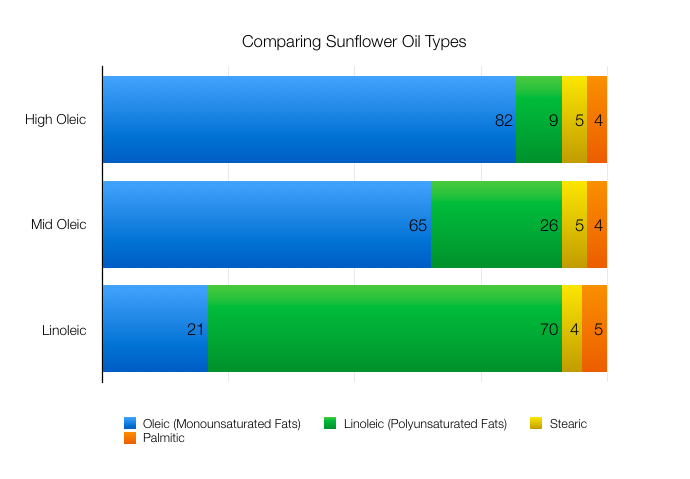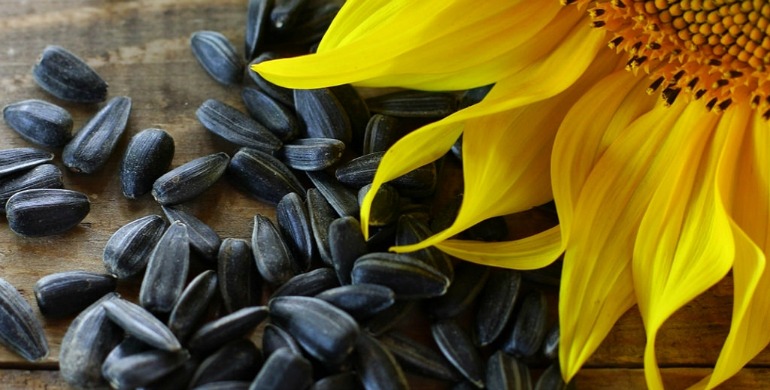
Did you know that there are different types of sunflower oil? Before you go choosing any old grade for your food product, it’s important to understand the difference. Some options can save on oil costs by extending your fry life, some stand up to heat and some are cheaper than others. Each type is fit for a specific purpose, so it’s best to choose the one with the best functionality for your new product line.
The primary differences between the grades have to do with the different levels and types of fat within the oil.
The grades of sunflower oil are:
High Oleic Sunflower Oil
Mid Oleic Sunflower Oil
Linoleic Sunflower Oil or Classic Sunflower Oil
High oleic oils are considered the most healthy, and have the most monounsaturated fat that makes up the oil. Linoleic sunflower oil is comprised of more polyunsaturated fats (considered a less healthy fat) and mid oleic falls somewhere in between.
High Oleic and Mid Oleic Sunflower Oil also come in both expeller pressed and solvent expelled varieties. These terms express how the oil is removed from the seeds, and expand the total oil choices from the 3 above to 5 total (explained more below).
Linoleic Sunflower Oil
Traditional sunflower oils have fallen into two categories, one high in oleic acid (monounsaturated fat) and the other high in linoleic acid (polyunsaturated fat).

Linoleic acid is one of the essential fatty acids in the human diet, and linoleic varieties of sunflower oil contain nearly 70 percent polyunsaturated linoleic acid. Another 20 percent is in monounsaturated oleic acid, and the remaining 10 to 11 percent is saturated fat.
High Oleic Sunflower Oil
High oleic sunflower oil consists primarily of monounsaturated oleic acids, at around 80 percent of the total. Saturated fats and polyunsaturated linoleic acid make up the balance, in equal proportions (see graphic above).
Bulk high oleic sunflower oil is important in the manufacture of food products, because it remains stable without hydrogenation and will not go rancid in storage.
High oleic sunflower oil actually has higher monounsaturated fat levels than olive oil — and olive oil is known for containing this healthy fat!
Mid-Oleic Sunflower Oil
Mid-oleic sunflower oil takes a middle position between the two above oils, with monounsaturated oleic acid accounting for roughly two-thirds of the fat content, polyunsaturated linoleic acid at roughly 25 percent, and about 9 percent saturated fat.
As more growers begin to move to high oleic sunflower oil, this oil is in limited supply in recent years.
Monounsaturated & Polyunsaturated Fat Levels
Many arguments for or against sunflower oil have to do with the higher levels of polyunsaturated fat vs. monounsaturated fat. If you want to learn more about these type of fats, I’d recommend swapping over to read the following articles first:
Comparing Types Of Fat: Monounsaturated Polyunsaturated Saturated & Trans
Monounsaturated Vs. Polyunsaturated Vs. Saturated Fat: What Are They?
Omega 3, 6 & 9: What They Are And How They Add Up
As humans, we need both of these types of fat: mono and poly. Polyunsaturated fat used to be hailed in the 70s as the healthy fat. That said, science has developed quite a bit since then and they are learning that monounsaturated fats are actually the “healthy-for-you” fats.
We do need some level of polyunsaturated fats, but it’s not very high. We need a much higher level of monounsaturated fats, as these are the type of fats that protect rather than oxidize once they’re in your body.

Solvent Expelled Vs. Expeller Pressed
All sunflower oils can be solvent expelled or expeller pressed — this is merely a description of how the oil is pulled out of the seeds, no matter the type of seeds. Solvent expelled oils use a chemical like hexane to pull the oil out of the seed. Expeller pressed oils physically squeeze the oil out of the seed without using chemicals to extract it.
Most linoleic or classic sunflower oils use solvent expelling — this is just a matter of the price demand on this oil. Most people buying classic sunflower oil are looking for a lower cost, and solvent expelling matches up with that.
On the other hand, a lot of the high oleic (healthier) sunflower oil on the market is expelled using an expeller press. That said, it still can be solvent expelled so it’s important to look for the description “expeller pressed” version if you want it.
Mid oleic oils can be either expeller pressed or solvent expelled, so it’s important to ask about this feature if you are looking for one or the other.
Topics: Sunflower/Safflower Oil












